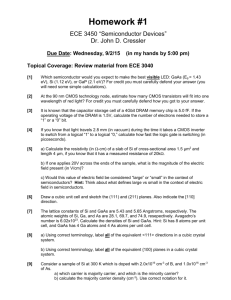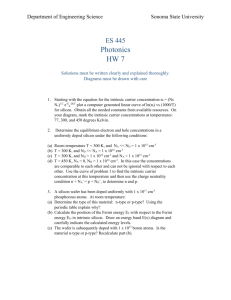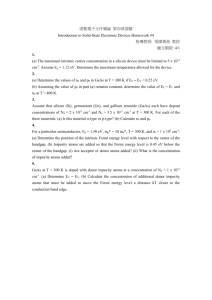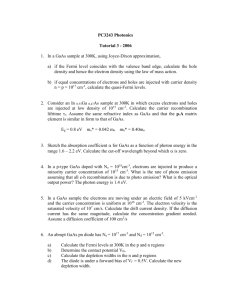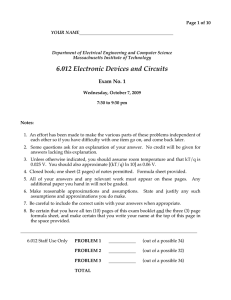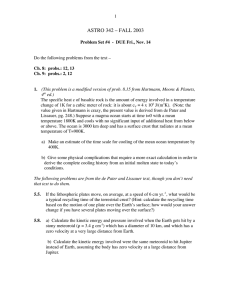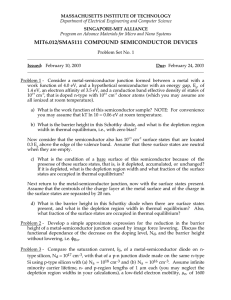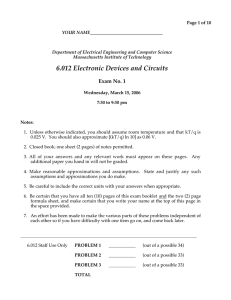6.012 MICROELECTRONIC DEVICES AND CIRCUITS
advertisement
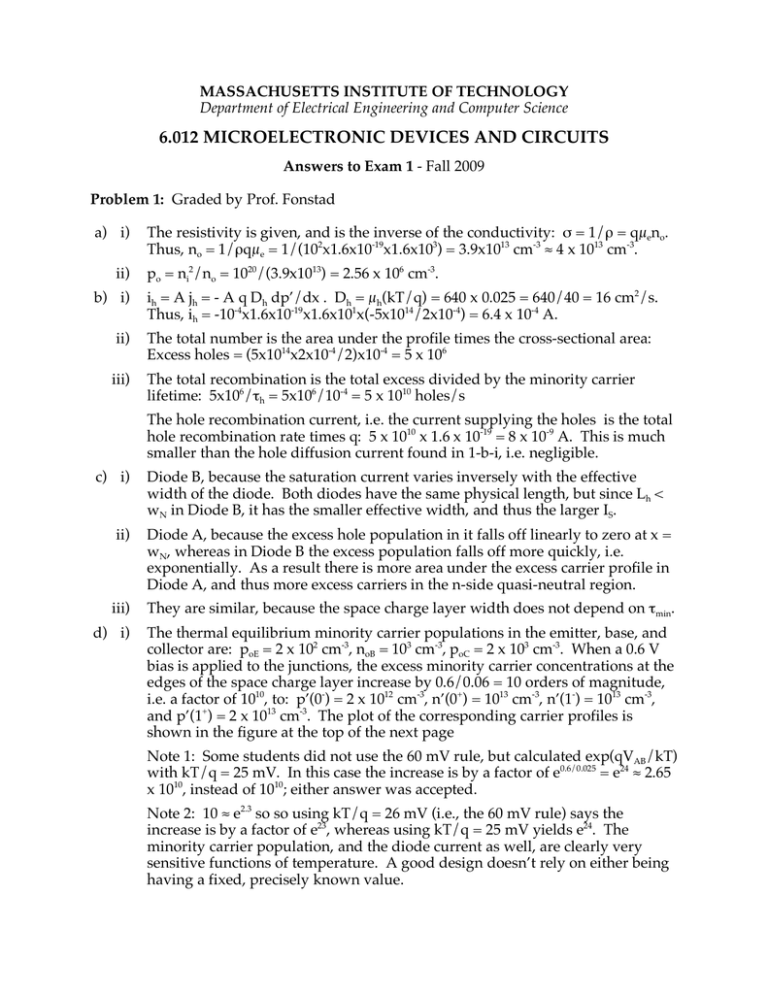
MASSACHUSETTS INSTITUTE OF TECHNOLOGY Department of Electrical Engineering and Computer Science 6.012 MICROELECTRONIC DEVICES AND CIRCUITS Answers to Exam 1 - Fall 2009 Problem 1: Graded by Prof. Fonstad a) i) The resistivity is given, and is the inverse of the conductivity: σ = 1/ρ = qµeno. Thus, no = 1/ρqµe = 1/(102x1.6x10-19x1.6x103) = 3.9x1013 cm-3 ≈ 4 x 1013 cm-3. ii) po = ni2/no = 1020/(3.9x1013) = 2.56 x 106 cm-3. b) i) ih = A jh = - A q Dh dp’/dx . Dh = µh(kT/q) = 640 x 0.025 = 640/40 = 16 cm2/s. Thus, ih = -10-4x1.6x10-19x1.6x101x(-5x1014/2x10-4) = 6.4 x 10-4 A. ii) The total number is the area under the profile times the cross-sectional area: Excess holes = (5x1014x2x10-4/2)x10-4 = 5 x 106 iii) The total recombination is the total excess divided by the minority carrier lifetime: 5x106/τh = 5x106/10-4 = 5 x 1010 holes/s The hole recombination current, i.e. the current supplying the holes is the total hole recombination rate times q: 5 x 1010 x 1.6 x 10-19 = 8 x 10-9 A. This is much smaller than the hole diffusion current found in 1-b-i, i.e. negligible. c) i) Diode B, because the saturation current varies inversely with the effective width of the diode. Both diodes have the same physical length, but since Lh < wN in Diode B, it has the smaller effective width, and thus the larger IS. ii) Diode A, because the excess hole population in it falls off linearly to zero at x = wN, whereas in Diode B the excess population falls off more quickly, i.e. exponentially. As a result there is more area under the excess carrier profile in Diode A, and thus more excess carriers in the n-side quasi-neutral region. iii) They are similar, because the space charge layer width does not depend on τmin. d) i) The thermal equilibrium minority carrier populations in the emitter, base, and collector are: poE = 2 x 102 cm-3, noB = 103 cm-3, poC = 2 x 103 cm-3. When a 0.6 V bias is applied to the junctions, the excess minority carrier concentrations at the edges of the space charge layer increase by 0.6/0.06 = 10 orders of magnitude, i.e. a factor of 1010, to: p’(0-) = 2 x 1012 cm-3, n’(0+) = 1013 cm-3, n’(1-) = 1013 cm-3, and p’(1+) = 2 x 1013 cm-3. The plot of the corresponding carrier profiles is shown in the figure at the top of the next page Note 1: Some students did not use the 60 mV rule, but calculated exp(qVAB/kT) with kT/q = 25 mV. In this case the increase is by a factor of e0.6/0.025 = e24 ≈ 2.65 x 1010, instead of 1010; either answer was accepted. Note 2: 10 ≈ e2.3 so so using kT/q = 26 mV (i.e., the 60 mV rule) says the increase is by a factor of e23, whereas using kT/q = 25 mV yields e24. The minority carrier population, and the diode current as well, are clearly very sensitive functions of temperature. A good design doesn’t rely on either being having a fixed, precisely known value. n’, p’ [cm -3] 2x10 13 1013 2x10 12 -1 0 x [!m] 1 2 3 ii) β ≈ 1/δE = (NDE/NAB)(Dh/De)(WB/WE) = (5x1017/1017)(40/15)(1/1) = 13.3 iii) The choice is between emitter and base, and from the expression above we see the correct choice to increase the doping of the emitter, which increases β. We want to make β 100/13.3 = 7.5 times bigger, so we should increase NDE by a factor of 7.5 to 3.75 x 1018 cm-3. Problem 2: Graded by Prof. Palacios a) φ(-1.5 µm) = -(kT/q) ln(1017/1010) ≈ -7 x 0.06 = - 0.42 V φ(1.5 µm) = (kT/q) ln(1017/1010) ≈ 7 x 0.06 = 0.42 V Δφ = φ(1.5 µm) − φ(-1.5 µm) = 0.42 – (-0.42) = 0.84 V b) ρ(x) = 160 x for -5x10-5 cm < x < 5x10-5 cm (i.e.- 0.5 µm < x < 0.5 µm), and ≈ 0 elsewhere. !(x) [coul/cm3] 8 x 10-3 -2 -1 x [!m] 0 1 2 -8 x 10-3 c) E(x) = ∫ρ(x) dx/εSi= 8x1013 (x2 – 2.5x10-9) for - 5x10-5 cm < x < 5x10-5 cm, and ≈ 0 elsewhere. The peak value is -2x105 V/cm at x = 0. E(x) [V/cm] -2 x 105 d) We can obtain the potential step between - 0.5 µm and 0.5 µm by integrating the electric field over this range. Doing this yields: φ(x) = -8x1013[ (x3/3) – 2.5x10-9 x]. Using this: φ(-0.5µm) = -6.67 V, and φ(0.5µm) = 6.67 V, so ΔφDepl. Reg. = 13.34 V. e) Between x = 0.5 µm and x = 1.0 µm, the doping changes by a factor of 2. Thus, using the 60 mV rule, the electrostatic potential must change by 0.06 x log 2 Volts, or 0.06 x 0.3 = 0.018 V. Δφ = 0.018 V between x = - 1.0 µm and x = - 0.5 µm, also. f) !(x) [V] 6.69 10 6.67 13.38V -2 -1 0 -6.67 -10 1 2 x [!m] -6.69 g) In thermal equilibrium, Δφ crossing the junction, φb, from Part a, is 0.84 V. Now the total change, (φb-VAB), is 0.02 + 13.34 + 0.02 = 13.38 V. Subtracting, we find the applied voltage, VAB: VAB = -12.54 V Problem 3: Graded by Prof. Weinstein a) B.C. @ x = 0: n’(0) = 0. B.C. @ x = L: n’(L) = 0. b) We require Le >> L, and since Le = (Deτe)1/2, we must have τe >> L2/De c) Crossing the plane of injection at XA, n’ must be continuous, and the sum of the carrier fluxes away from XA must be M. So, the constraint on n’ is n’(XA-) = n’(XA+), and the constraint on dn’/dx is De(dn’/dx|XA- - dn’/dx|XA+) = MA. d) For 0 < x < XA: n’(x) = n’(XA) x/XA, and for XA < x < L, n’(x) = n’(XA) (L-x)/(L-XA). Note: The value of n’(XA) is most easily found after first solving Part e, see below. n’(x) n’(XA) =MXA(L-XA)/DeL n’(XA) n’(x) = n’(XA)·(L-x)/ (L-XA) n’(x) =n’(XA)·x/ XA x 0 XA L e) For 0 < x < XA: Je,diff(x) = qDen’(XA)/XA; for XA < x < L, Je,diff(x) = - qDen’(XA)/(L-XA). The current step at x = XA must be qMA. Using this gives n’(XA) = M XA(L-XA)/DeL; thus: Je,diff(x) = qMA(L-XA)/L for 0 < x < XA, and Je,diff(x) = qMAXA/L for XA < x < L. J e,diff (x) qMA(L-XA)/L 0 -qMAXA/L qMA XA x L f) Minority carriers flow primarily by diffusion because any minority carrier drift current must be negligible compared to the majority carrier drift current because in low level injection the majority carriers far outnumber the minority carriers. g) Superposition is valid, so the excess minority carrier populations and the minority carrier drift currents due to each excitation, MAδ(XA) and MBδ(XB), individually can be superimposed, i.e. added: n’(x, gL = MAδ(XA) + MBδ(XB)) = n’(x, gL = MAδ(XA)) + n’(x, gL = MBδ(XB)) Je,diff(x, gL = MAδ(XA) + MBδ(XB)) = Je,diff(x, gL = MAδ(XA)) + Je,diff(x, gL = MBδ(XB)) __________________________ Exam Statistics Average/Standard deviation: Class median: Problem 1 Problem 2 Problem 3 Total 26.4 23.0 18.8 68.3 4.9 6.2 6.4 14.3 68.5 Distribution to nearest 5: Find your face in this picture 20 30 40 50 60 Total Score -σ 70 Ave & Mean 80 90 +σ 100 MIT OpenCourseWare http://ocw.mit.edu 6.012 Microelectronic Devices and Circuits Fall 2009 For information about citing these materials or our Terms of Use, visit: http://ocw.mit.edu/terms.
